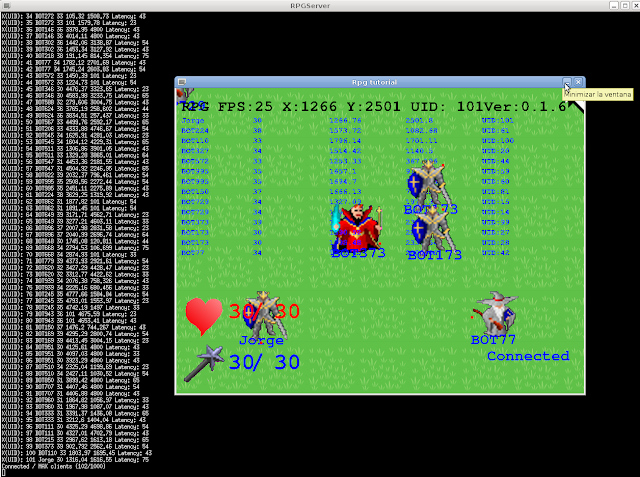<Messaging:>
Networking is the core of an mmorpg, and just in the top of the network we have the messaging system. What we need is to create a way to communicate between server and clients.
Clients will send commands to the server for example: move forward, turn right, atack!... In the server we could have comands to send the map, the clients data like player / npc position,etc...
Most of the people (should) use serialization to send data, for example an item could be packed in an object / serialize it and send over the net, in the destination it would be deserialized and here we have our object/item again, but I have used another way to transfer messages that is hard to code but easier to understand: Plain-text messages.
Probably now you are wondering about how does it works, suppose we want our client to send to the server we are moving forward, then we will just send a command telling the server we have pressed "forward", suppose we decide the text command is going to be "/acce", when the server receives a string "/acce" from our client it will understand the client is moving forward so it will move the client forward in the map and return the new updated position to the client; The server will send "/ping" to the clients every x seconds ,when the clients receive "/ping" it will return "/pong" to measure delay in the communication between server/clients.
What are the advantages when using this method? basically it simplifies debugging , it's easier to understand an incoming packet when you can actually see the command and not a binary-format hex value, basically it is good for didactic purposes.
The disadvantages? performance and scalability , "/acce" uses 5 bytes to send "forward", too much for a simple commands in the other side for every new command you have to modify both client and server, that can be overwhelming!
I resume here all the commands I used for the demo:
Client side:
- /nick > Set players nickname
- /imag > Set players image
- /acce > Move forward
- /dece > Move backward
- /righ > Turn right
- /left > Turn left
- /idle > Stay idle
- /pong > Answer a /ping request
- /quit > Exit server
Server side:
- /SUID > Send Unique identifier to the player
- /upda > Send non-player updates (X,Y,Nicknames...)
- /updb > Send player updates (X,Y...)
- /ping > Send a /ping request to calculate client latency
- /kill > Sent when a player logoffs
We will start moving around, when we move we will be sending "/acce", "/dece", "/righ" and "/left" to the server that will update our position in the map, if we don't move a "/idle" message will be sent, when the server updates our position it will mark if the client has changed state so it will send the command "/upda" with our updated x and y to the clients in a range (500px), so server wont send updates to clients that can't see our moves, that will limit too network traffic.
When a clients exits the game it sends a "/quit" to the server, server will clean the players data and then it will send a "/kill" command to the clients so they will clean the exiting client...
<9 messages for the client + 5 messages for the server = total 14 diferent messages! , Probably the simplest messaging system you will have ever seen>
<Optimizations:>
After I made the server I saw two simple ways to improve performance: first one in the client second one in the server:
- In the client I was sending 25 messages/ second to the server: I was sending data no mather if it was moving or if it was idle, but I thought that instead sending messages all the time I could only send data when a change was detected, for example: the client is idle, so the first time, it will send "/idle", but if it keeps standing still it wont keep sending "/idle", server will save the command until a new one arrives, so after a while I start to move forward, I send a "/acce" to the server first time, but again if I keep on moving forward it wont send again "/acce".. that divided outgoing messages from 25 to 2 or 3 messages when moving and 0! standing still.
- In the server I checked the messages and found that "/upda" >> (client updates) was about 99% of the outgoing traffic, that generated a huge problem when a client was in a crowded area, suppose there are 50 clients near, all them are moving so every client is generating 50 updates / frame, with a frame rate of 20 /s that was 50 * 50 * 20 = 50.000 messages in a second!!! that was making the server collapse, so I had an idea, why not nest packets? when a "/upda" is generated I made the server to don't send that message instantly , instead of that it "packed" into a bigger message, when more "/upda" messages arraived they were packed up to 10 updates in a bigger one, so in the same "crowded" are messages sent will be reduced to 5.000, that was much more reasonable.
<Blocking versus non blocking sockets in the next post>

































